This overland adventure leads you into exotic Tibet. You will begin your journey in lush green Nepalese valleys before crossing the 'Roof of the World' and finally arriving in Lhasa, the heart of Tibet. Travel across the Tibetan plateau to explore more sacred places and experience incredible Tibetan culture. Enjoy unparalleled vistas of Mt. Everest from its base camp. Enjoy Tibet's main sights and superb scenery, followed by a spectacular journey to charming Lhasa from Kathmandu. ( (Gyirong Port has been opened for foreign travelers. From 30 August, 2017, foreign travelers can enter Tibet from Nepal or leave Tibet for Nepal at Gyirong Port again.)
Highlights of this tour:
- Make fully use of the convenient access into Tibet from Kathmandu in Nepal. In this tour, you will drive along the Sino Friendship Highway to Lhasa;
- Go to have a wonderful expenditure to the top of the world - Mount Everest, and enjoy her magnificent beauty;
- Visit the First Palace and First Buddhist Monastery in Tibet's history - Yumbulakang and Samye Monastery;
- Experience Tibetan culture and history in its most popular capital city Lhasa, and explore famous attractions, such as Potala Palace, Jokhang Temple, Barkhor Street, Sera Monastery, etc.;
Tour Brief Information
- Tour price: from
- Tour code: TD-OT-9A
- Tour Type: Private Customizable Tour Package
- Destination: Kathmandu / Gyirong / Mt. Everest / Shigatse / Tsetang / Lhasa
- Duration: 9 days and 8 nights
- Departure: Flexible
- Travel Theme:





- Best Time:



- Physical Level
- Tour Pace
Medium
- Max Altitude
5,200m
- Itinerary Details
- Price Guide & Booking
- Trip FAQs
- Reviews
- Make an Enquiry
Your tour - at a glance
Day 1~3 Nepal to Shigatse via Mount Everest
Day 4~6 Shigatse to Tsetang via Gyantse
Day 7~9 Lhasa Tour & Departure
Itinerary Details - Day by Day
Day 1 Kathmandu - Tibet Border - Gyirong Town
Today you can take a local bus or private car to Gyirong Port (altitude: 1800m) at China-Nepal border. Though the distance is only about 160km, it takes more than 6 hours to drive to Gyirong Port from Kathmandu because the road is narrow and bumpy.
After arriving at Gyirong Port, you will check through the custom, and be picked up by our Tibetan tour guide at Tibet side, then drive about 25km to Gyirong Town (altitude: 2600m) for accommodation.
Tip of today: Make sure your Group Visa and Tibet Travel Permit are issued before departing to Tibet.
Day 2 Gyirong - Mount Everest
After breakfast, you will have a long driving to Mount Everest (about 360 km). Though being a long driving of about 8 hours, but the views along the road are stupendous. In clear days, you can see the clear face of Mt. Shishapangma and enjoy the beautiful view of Pekutso Lake. When you finally get to Rongbuk Monastery, and get the first sight of the mighty Everest, you will immerse in a solemn ethereal mood and find all the efforts you have made along the long way are not in vain. Located about 5100 meters above the sea level, Rongbuk Monastery is the highest monastery in the world. It is the best location to take some great photos of the front face of Mount Everest. The rest of today is free for you to visit the Rongbuk Monastery and explore the nearby Everest Base Camp. Take photos with the Everest altitude marker and EBC marker to commemorate your wonderful adventure tour.
Accommodation: if you visit Mount Everest during the off season (November to April), you will accommodate at Rongbuk Guest House near the Rongbuk Monastery; if you visit Mount Everest during the peak season (May to October), you will accommodate in a local Tibetan tent at Everest Base Camp near Rongbuk Monastery which is only run between May and October by local Tibetans. Please note that the accommodation at both places is very simple and basic, only dorm beds with communal squat toilets are available. Duvets, heated blankets and hot water will be provided, and you are suggested to bring your own sleeping bag and toilet paper. There is no running water, sinks or showers. The dining room just offers basic breakfast and dinner without menu. Remember to dress warmly all the time.
Tips of today: 1) the altitudes rise from 2,600 meters to 5,100 meters during the driving from Gyirong Town to Rongbuk Monastery. Please prepare well to avoid high altitude sickness. Not to take any strenuous activity which may cause high altitude sickness easily; 2) bring a warm coat for low temperatures on Mount Everest.
-
 Rongbuk Monastery on the Mount Everest
Rongbuk Monastery on the Mount Everest
-
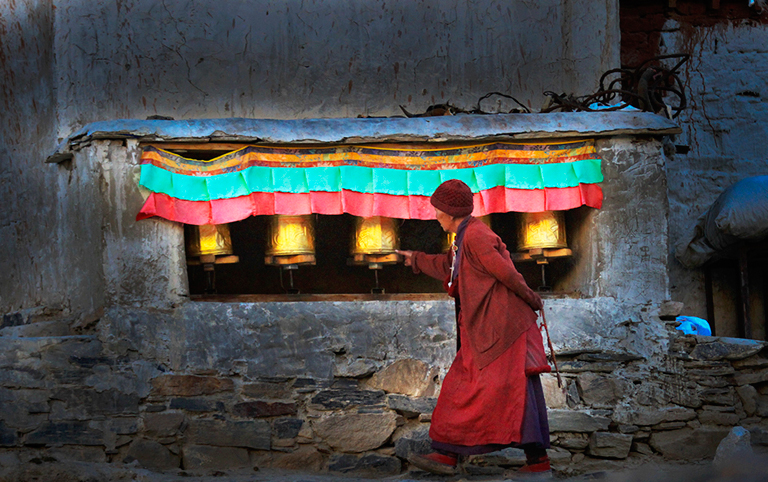 A devoted pilgrim in Rongbuk Monastery
A devoted pilgrim in Rongbuk Monastery
-
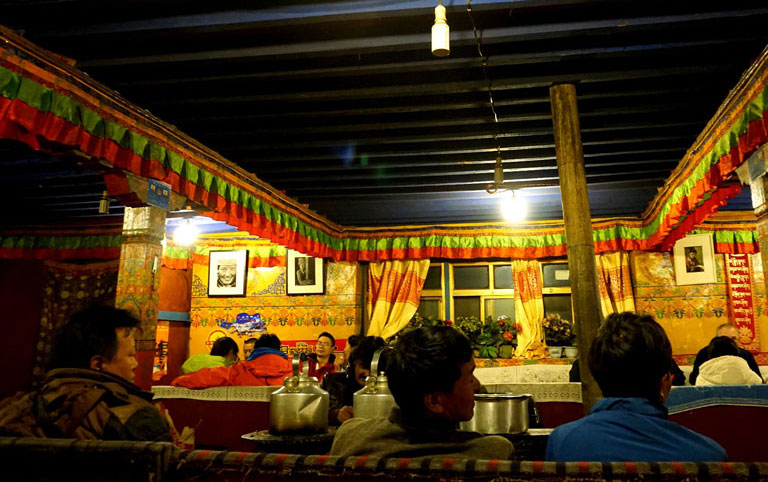 Dining Room in Rongbuk Monastery Guesthouse
Dining Room in Rongbuk Monastery Guesthouse
Day 3 Mount Everest - Shigatse ( B )
Wake up early to enjoy the marvelous sunrise on the peak of the world. Then drive about 4km further to Tibetan Tents Camp (altitude: 4900m) where you can enjoy a closer view of Mount Everest.
The top part of the Mount Everest is always covered by snow all the year round, and when the sun shines on the mountain, the peak is like a giant white pyramid, which is one of the most famous sceneries of Mount Everest. In bright days, you can also see a wisp of cloud hanging above the top of Mount Everest. It flies eastward in the fast western wind just like a flapping flag. This unique phenomenon is the spectacular “Cloud Flag”. The cloud will change from surging waves into a thin cooking smoke or from galloping steeds into the mysterious veil of a goddess.
Till now your Mount Everest adventure is about to end. The rest of today is to drive back to Shigatse City. Have a good rest in Shigatse City.
Tips of today: 1) to protect the environment of Mount Everest, currently Everest Base Camp is not open for tourists – the Everest landscape can be enjoyed at Rongbuk Monastery and Tibetan Tent Camp as well. The base camp marker, a tablet reading “Mt. Qomolangma Base Camp” has been transferred to the Tibetan Tent Camp. You are suggested to take a photo at the marker to commemorate your wonderful adventure tour; 2) the sunrise usually starts around 6:30 am to 7am on Mount Everest; 3) keep warm all the time.
-
 Peaceful Morning of Everest
Peaceful Morning of Everest
-
 Wonderful View of Mount Everest
Wonderful View of Mount Everest
Day 4 Shigates - Gyantse ( B )
Today, before driving to Gyantse from Shigatse, take a visit to the official seat of Panchen Lama - Tashilhunpo Monastery which is also the largest and most influential Gelug Monastery in Shigatse prefecture. Here you will see a giant statue of Future Buddha, the largest one of its kind on earth ( 26.2 meters high and 11.5 meters wide ), decorated with precious pearls, turquoises, corals and ambers.
After arriving at Gyantse, go to visit the mysterious Palcho Monastery. The monks and tradition of three important sects of Tibetan Buddhism - Sakyapa, Zhalupa and Gelukpa, peacefully coexist in this monastery. Its Kumbum, which is 35 meters high and has 76 small chapels with hundreds images of Kriyatantras , is believed to be the largest such structure in Tibet. Finishing the visit in Palcho, go to take some photos of the Gyantse Dzong Fortress on which the Tibetan army used to fight against the British army's invasion during the early 20th century. It is a very impressive fortress with typical Tibetan palace architecture style which is inherited from Yumbulagang Palace - The First Palace of Tibet.(Gyantse Dzong Fortress now is closed for maintenance. Tourists cannot climb up to the top, but still can enjoy its magnificent appearance from the square at the foot of the Dzong Hill.)
Accommodate at Gyantse Town.
-
 Glorious architecture of Tashilhunpo Monastery
Glorious architecture of Tashilhunpo Monastery
-
 Overview of Palcho Monastery from Dzong
Overview of Palcho Monastery from Dzong
-
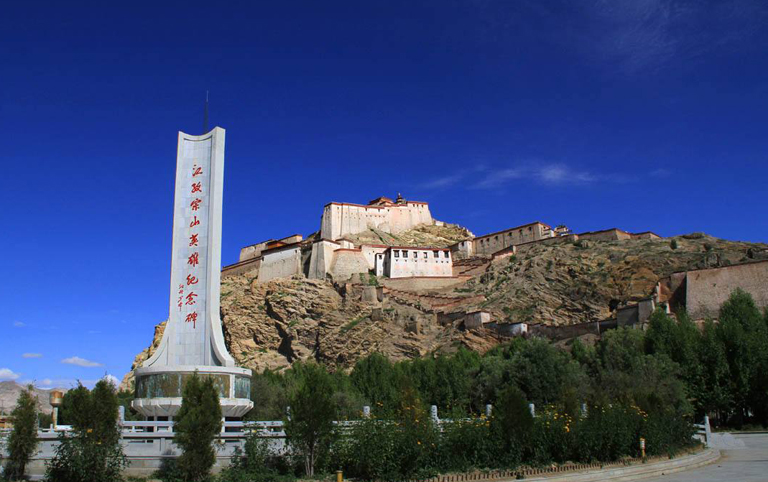 Gyantse Dzong Fortress
Gyantse Dzong Fortress
Day 5 Gyantse - Yamdrok Lake- Tsetang ( B )
Today, you will drive head to Tsetang Town. After a driving of about 75km, you will see the imposing Karola Glacier towering aloft on the right side of the road. Keeping driving for a while, you will get to Yamdrok Lake. As the largest fresh lake in the northern of the Himalaya Mountains, it spreads about 675 square meters from south to north, like an eardrop lying in the arms of snow-capped giant mountains. Viewing from a distance, you can see fertile pastures full of yaks and sheep, and some small Tibetan villages along the lakeshore.
Continuing your trip, you will lastly arrive at Tsetang Town which is the political and transportation center of Shannan Prefecture. This region is the birthplace of Tibetan Civilization, as well has played an important role in the development of Tibetan Buddhism. Today, you will go to visit three most famous attractions in Tsetang. After a brief rest, go to visit the first palace in Tibetan history - Yumbulakang. It has a very long history, and boasts many sculptures and paintings from ancient times. While visiting Trundruk monastery, you will see a stunning Tangkha of Pearls decorated with a total of 29,026 pearls. (Yumbulakang is now closed for maintenance. Tourists cannot climb up and visit sites inside, but still can enjoy its magnificent appearance at the foot of the hill.)
Have a good rest in Tsetang Town.
Tip of today: prepare some food and drinks for long driving of today.
-
 Lake Yamdrok Yumtso with the view of Mt. Nojin Kangtsang
Lake Yamdrok Yumtso with the view of Mt. Nojin Kangtsang
-
 Be shocked by the incredible scenery of Yumbulagang Palace
Be shocked by the incredible scenery of Yumbulagang Palace
Day 6 Tsetang - Samye Monastery - Lhasa ( B )
In the morning, you will drive about one hour to visit the famous Samye monastery which is believed to be the first official Buddhist monastery in Tibet with the basic terms of Buddhism – Buddha, scriptures and monks. For over 1,200 years of history, it is one of most influential monastery in Tibet. In this monastery, there was a famous debating about Buddhism between the ancient Indian Buddhism and Chinese Buddhism. Samye Monastery was built according to the description of universe in Buddhism scriptures, combined features of Tibetan, Chinese and Indian, symbolizing the center of the universe.
After the Samye visit, drive about 3 hours to Lhasa.
-
 Visit the first monastery in Tibet
Visit the first monastery in Tibet
-
 Samye Monastery Entrance
Samye Monastery Entrance
Day 7 Lhasa ( B )
Start today’s Lhasa exploration with an exciting visit to the landmark - Potala Palace which is regarded as one of the most beautiful architectural building in the world. You will climb up the palace along the zigzag stone paths with white-and-red walls to the top of the palace where you can not only appreciate the exotic Tibetan-style architecture, but also get a great view of Lhasa’s urban areas, then walk into the inner space of Potala Palace to explore the stately chapels and learn about the history of the palace.
Continuing your exploration, you will then get to Jokhang Templewhich is considered as the spiritual heart of Tibetan Buddhism. Each day, there are thousands of pilgrims coming from different places in Tibet to the temple to worship to the Buddha. This temple is also known as the “house of Buddha” because it keeps the precious Jowo Rinpoche, the life-sized (5 foot/1.5m) image of the Shakyamuni at the age of 12. The last site for today’s exploration is the famous Barkor Street. It is a circular and wide street encircling the Jokhang Temple. The local people like to walk on the street for several circles usually in the late afternoon as a daily tradition of pilgrimage. The street also has many shops selling a wide variety of traditional Tibetan goods, religious items and handcrafts.
Tips of today: 1) there are 1,080 steps up to climb to the top of Potala Palace, so don’t walk in a rush, which may cause high altitude sickness; 2) taking photos is not allowed inside the palace; 3) today you will be mainly outside, please bring some water, a hat, sun cream, and sun glasses with you.
-
 Enjoy a nice time in Potala Palace
Enjoy a nice time in Potala Palace
-
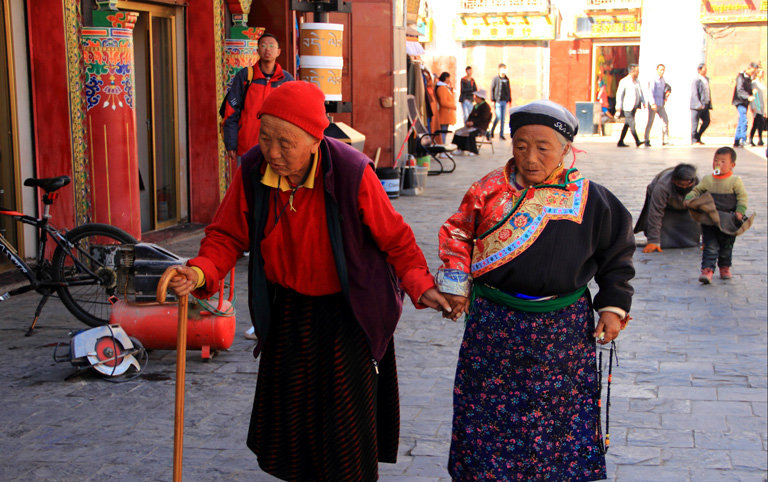 Old Tibetan Women on the Barkhor Street
Old Tibetan Women on the Barkhor Street
-
 Golden Roof of Jokhang Temple
Golden Roof of Jokhang Temple
Day 8 Lhasa ( B )
After breakfast, you will firstly go to visit the beautiful Norbulingka which used to be the former summer palace of Dalai Lamas in the ancient time, and now is a public park. It is famous for its Potrang, the private palaces of former Dalai lamas with grandiose Tibetan architecture style. Next, drive several kilometers to the western outskirts of Lhasa to visit Drepung Monastery. Drepung, in Tibetan, means “prosperity”. Since its establishment, Drepung Monastery has always been one of the most important Buddhist monasteries in Tibet. In its heyday, there were more than 10,000 monks lived and studied in the monastery. Throughout its history, many important and famous Tibetan leaders used to study here, especially the Dalai Lamas. So Drepung Monastery is also respectfully known as the “Mother School of Dalai Lamas”.
In the afternoon, you will be taken to another famous monastery in Lhasa - Sera Monastery. It is famous for the spectacular “Buddhism Debating”. As a daily routine, the monks gather in a courtyard, and debate on the Buddhist doctrines with supplemented gestures, which is thought to be helpful to facilitates better comprehension of the Buddhist philosophy to attain higher levels of study. After enjoying the "Buddhism Debating", you will be transferred back to the city. The rest time is your own free time to rest.
The Etiquette of Visiting Monastery: 1) you shouldn’t wear short and uncover shoulders; 2) taking off your sunglasses and hat before entering the chapels; 3) taking photos is usually not allowed inside the chapels.
-
 Debating Monks
Debating Monks
-
 Monks Gathered at the Entrance of Drepung Monastery
Monks Gathered at the Entrance of Drepung Monastery
-
 Enjoy the bright flowers in Norblingka
Enjoy the bright flowers in Norblingka
Day 9 Lhasa Departure ( B )
Today is free for you until your tour guide transfer you to the airport in time for your flight or drop you off at Lhasa train station.
Tips of today: 1. Please pack your luggage carefully, especially for small things like camera charger, power adaptor, mobile phone, phone charger, wallet and towel. 2. If your flight is arranged in the afternoon, please make sure you check out the hotel before 12pm.
Useful Trip Notes
- 1. Tibet Permits Guaranteed
To travel in Tibet, all Non-Chinese passport holders need to have a Tibet Travel Permit which is issued by Tibet Tourism Bureau in Lhasa. And only Chinese travel agencies like Tibet Discovery can apply for the permit on behalf of tourists. You must obtain it before your tour starting because the permit will be checked when you board your flight/train to Tibet. Traveling with Tibet Discovery, you don't have to worry about the complicated procedures of Tibet Travel Permit application. All you have to do is to confirm a tour package with us and send us your passport and Chinese visa copies at least 15~20 days in advance before your tour, then we will take care of all the rest things. Once the permit is issued, we will deliver to your address in mainland China, such as your hotel, local travel agency, etc. - 2. Available Months to Visit Tibet
Generally speaking, April to October is the best time. July and August are the peak season and rainy season. It is usually snowy and cold in winter, which is not suitable for visit Mount Everest, Namtso and Mount Kailash regions. While other places such as Lhasa, Gyantse and Shigatse are suitable for travel all year around. The temperatures in daytime and night differs a lot, usually 5~15℃ in the daytime and -5~0℃ in the night, so please wear accordingly. - 3. High Altitude Sickness
The average altitude of Tibet is about 4000 meters above the sea level (Lhasa: 3700m; EBC: 5200m; Namtso: 4718m). You may suffer a bit from High Altitude Sickness in the beginning days of your Tibet trip if you haven’t had rich high plateau travel experience. But don’t worry too much, the high altitude can be acclimatized usually in 2~3 days. Our suggestion is to take a physical examination and get suggestions from your doctor, and also bring some medicines to prevent from High Altitude Sickness before your trip. While in Tibet, you should keep warm all the time, avoid strenuous activities, drink more water and eat more vegetables and carbohydrates. You’d better not take showers during the first two days after your arrival in Tibet. If you don’t feel well, get help from your tour guide or go to the hospital without any delay. - 4. How to Go to Tibet from Nepal
Currently, you have two options - flight and overland driving. The most convenient and fastest way is to take a 1.5 hours' flight to Lhasa from Kathmandu directly, and usually there are about 1~2 daily flights operated. Another way is to drive to Tibet from Nepal crossing the border, and it takes about at least 6 hours to the Gyirong Port from Kathmandu by driving. Then you can travel to Lhasa from Gyirong Port to start your Tibet travel. You can stop by to visit Mount Everest, Tashilhunpo Monastery, Yamdrok Lake, etc. en route. - 5. Packing and Wearing Ideas
Firstly you can’t forget your passport and Chinese Visa. A large backpack and a smaller one are recommended (the smaller one can be used for daily activities). Also bring necessary medicine you need. Other stuffs like sunglasses, snow glasses, hats, lip balm, sun block are recommended.
As for wearing, you are suggested to dress in layers (both thin and thick jackets). Down jacket is necessary in Spring and Autumn. A pair of durable and comfortable shoes is necessary.
Recommended Tibet Group Tour Packages
Escorted by a skilled driver and companied by a professional local tour guide to organize all the activities, all you have to do is to enjoy your fantastic Tibet journey.Following are some other recommended Tibet group tour packages that you may be interested in. You can also contact us to customize a trip if you want..
-
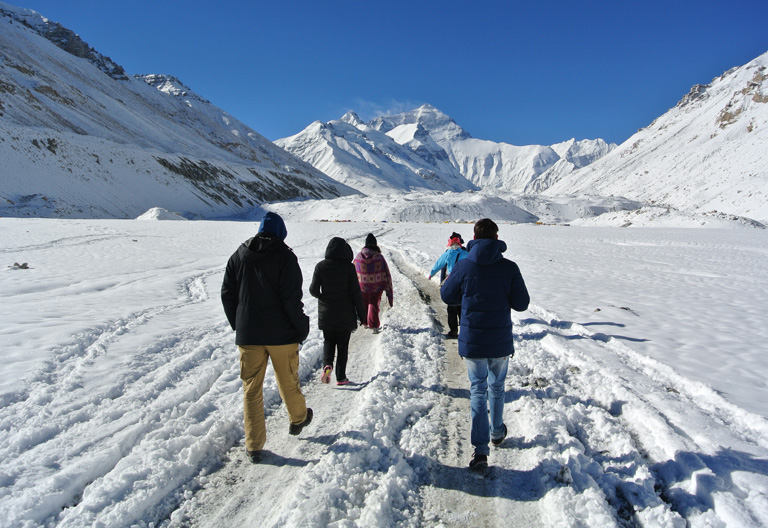
Kathmandu - Gyirong - Everest - Shigatse - Gyantse - Lhasa
7 Days Kathmandu to Lhasa Private Tour via Mount Everest
Highlights: Mount Everest, Tashilhunpo Monastery, Yamdrok Lake, Potala Palace
-

Lhasa / Gyantse / Shigatse / Mount Everest / Gyirong
7 Days Lhasa to Gyirong Border Overland Tour via Mount Everest
Highlights: Potala Palace, Yamdrok Lake, Palcho Monastery, Mount Everest
-
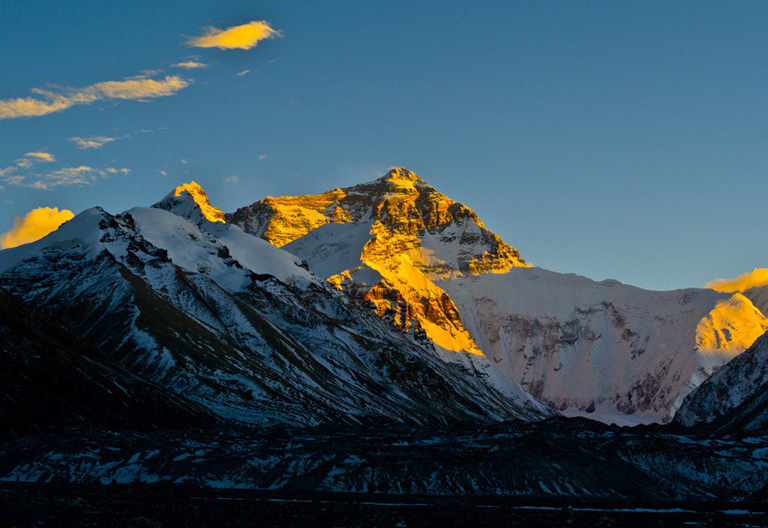
Kathmandu / Lhasa / Gyantse / Shigatse / Everest / Gyirong / Kathmandu
8 Days Kathmandu to Lhasa with Mount Everest Adventure by Flight
Highlights: Potala Palace, YamdrokLake, Tashilhunpo Monastery, Mt. Everest




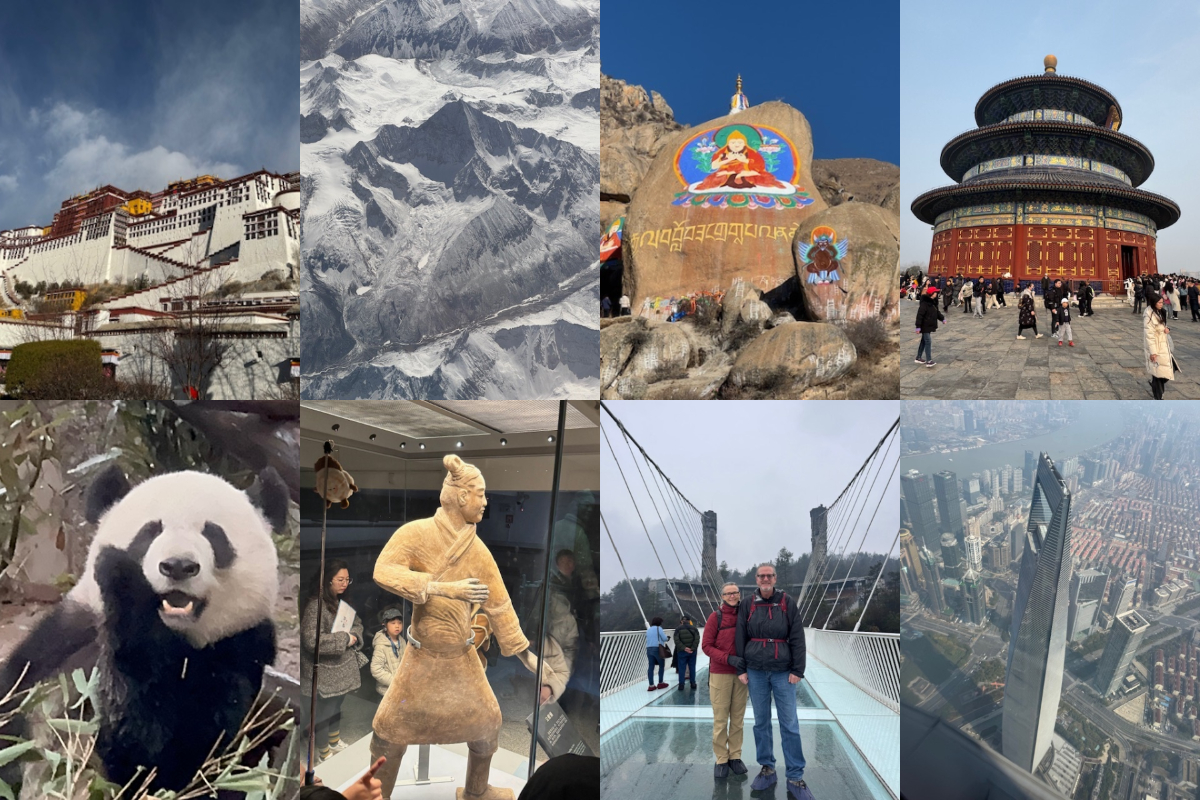

 Karen
Karen Wonder
Wonder Jack
Jack Rita
Rita Johnson
Johnson Vivien
Vivien Wing
Wing Ariel
Ariel Leo
Leo Tracy
Tracy Evelyn
Evelyn April
April Phoebe
Phoebe Kelly
Kelly Shirley
Shirley Reya
Reya Juliet
Juliet Elk
Elk Felix
Felix Sean
Sean